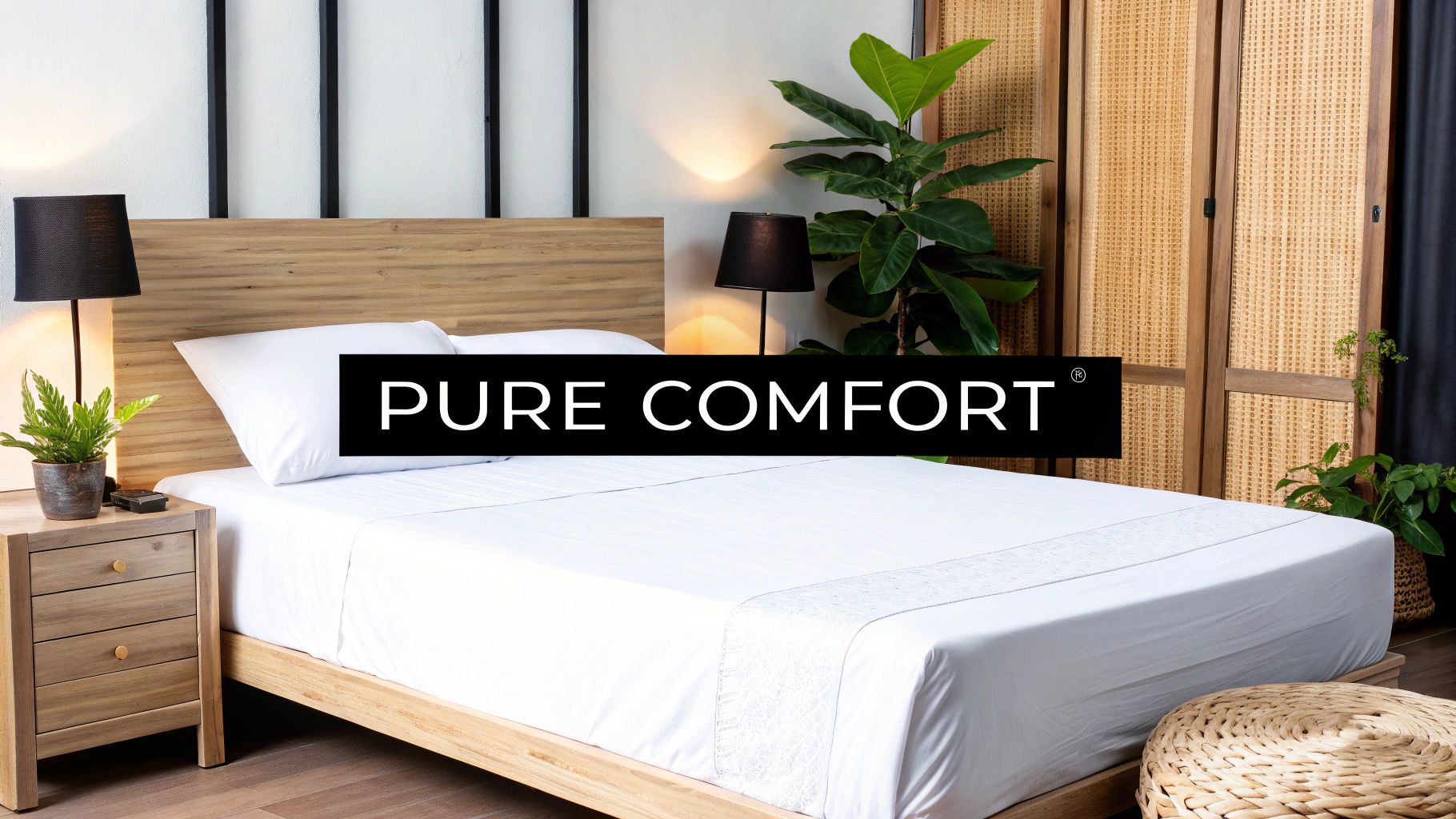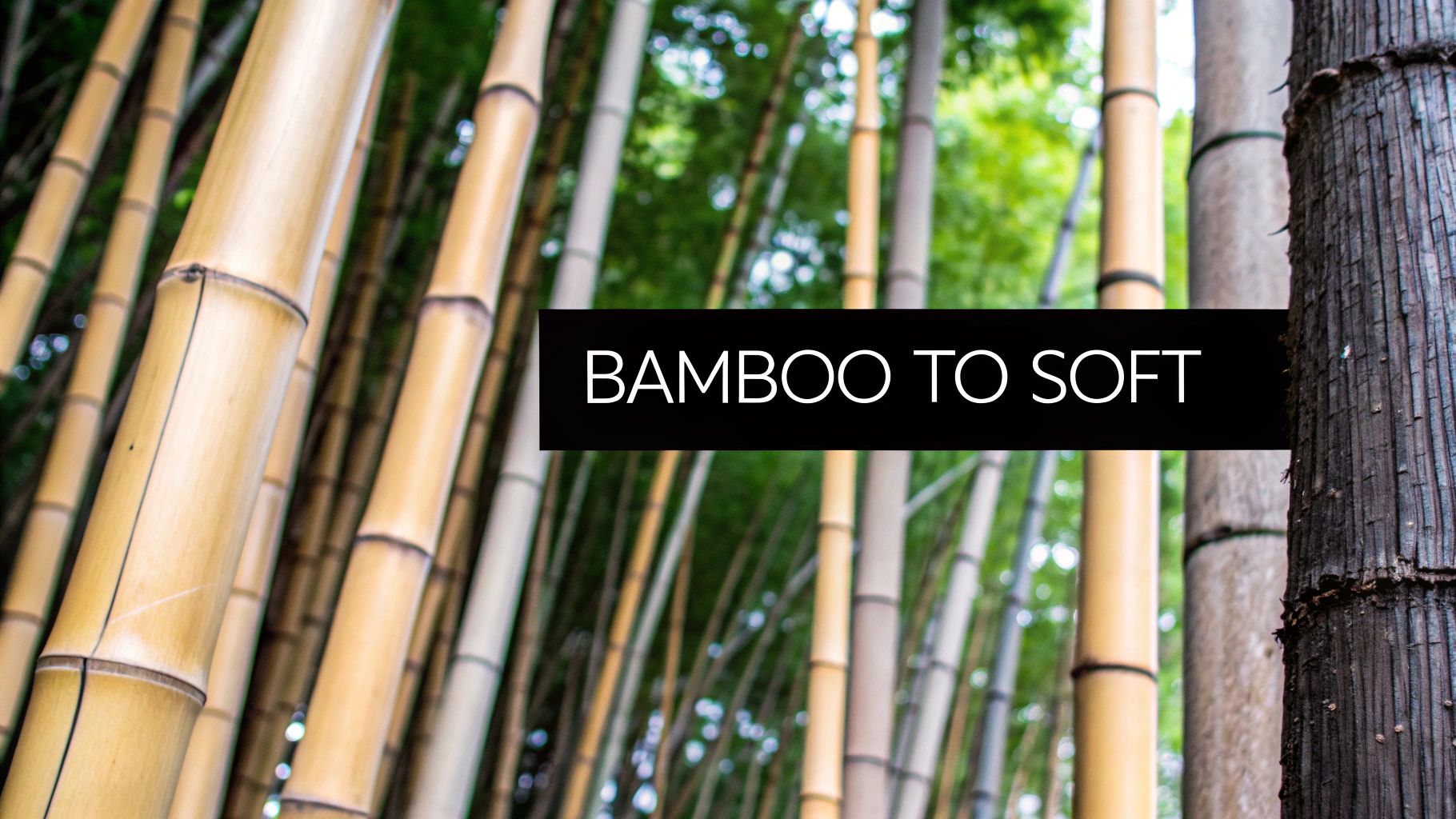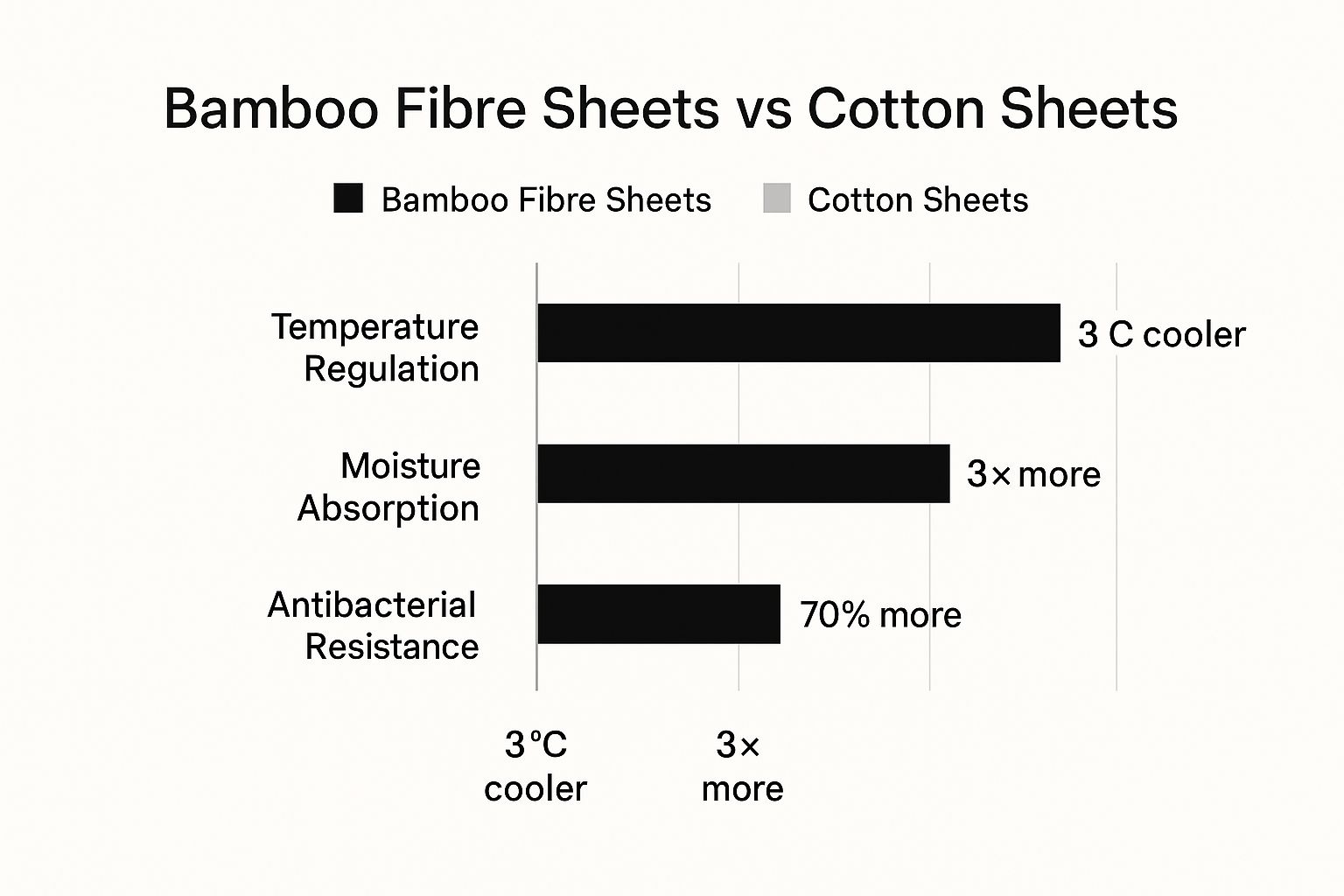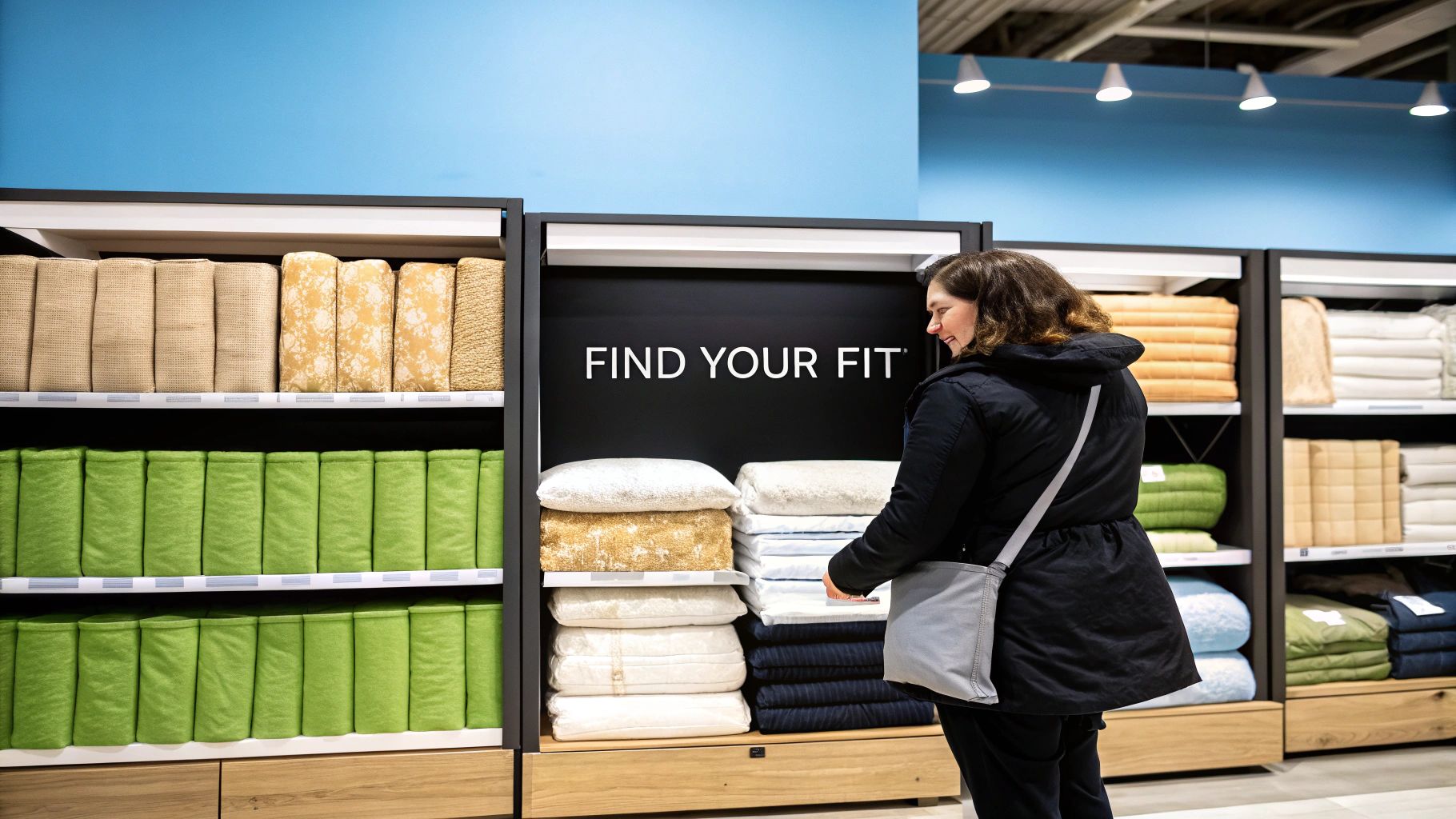Ever wondered if your bedding could actually help you sleep better? Imagine sinking into sheets so soft and cool they transform your entire night's rest. That's the promise of bamboo fibre sheets, a luxurious and eco-friendly choice that’s quickly becoming a favourite in Australian homes. If you're tired of overheating or waking up to scratchy fabrics, this guide will show you why bamboo might be the perfect upgrade.
We’ll cover everything you need to know, from how they feel to how to care for them, giving you clear, practical advice to help you decide if they're right for you.
Why Bamboo Bedding is Gaining Popularity

So, what’s the big deal with bamboo? Unlike traditional cotton, bamboo fabric is made from the pulp of the fast-growing bamboo plant. The result is a textile famous for its incredible softness, breathability, and sustainable origins.
This isn't just a fleeting trend. The Australian bedsheet market is growing, driven by a strong consumer demand for sustainable and high-quality options. According to market research, the demand for eco-friendly bedding materials in Australia is a key factor in the industry's expansion. This shows a real shift in what people value for their homes and their sleep.
The Key Benefits Driving the Switch
People are making the change for simple, practical reasons that solve common sleep problems. If you've ever struggled with overheating at night or have sensitive skin irritated by rough fabrics, bamboo sheets offer a direct solution.
- Unbelievable Softness: The feel is often compared to silk or high-end Egyptian cotton. This luxurious texture makes getting into bed a truly comforting experience.
- Natural Climate Control: Bamboo fabric is highly breathable. It wicks moisture away from your body, helping you stay cool and dry, even on warm nights. Research has found that sleep quality is closely linked to thermal comfort, making breathable bedding a key factor for a restful night.
- Naturally Hypoallergenic: For those with allergies or sensitive skin, this is a game-changer. Bamboo is naturally resistant to dust mites and mould, promoting a cleaner, healthier sleep environment.
This unique combination of luxury feel and practical, health-conscious benefits makes bamboo bedding an ideal choice for the modern sleeper.
How Bamboo Fibre Sheets are Made
It’s amazing that a tough bamboo stalk can become a fabric softer than silk. The process is a fascinating blend of nature and technology. It starts with harvesting mature bamboo, a highly renewable grass that grows incredibly fast without needing pesticides.

The bamboo is crushed into a pulp rich in cellulose. This pulp is then processed to extract the fine fibres that are spun into yarn. The method used for this extraction is what defines the quality and eco-friendliness of the final product.
From Plant Pulp to Silky Thread
The two most common methods for creating bamboo fabric are the viscose and lyocell processes. To understand the difference, it helps to know what bamboo viscose is and how it's made.
The viscose process involves dissolving the bamboo pulp in a chemical solution to extract cellulose fibres. While effective, traditional methods used harsh chemicals. Today, responsible manufacturers use refined processes to minimise environmental impact.
A greener and more advanced method is the lyocell process. It uses a non-toxic solvent in a 'closed-loop' system, where over 99% of the solvent and water is recovered and reused. This drastically reduces waste and creates a stronger, smoother fibre, making it the premium choice for both quality and sustainability.
Weaving the Final Fabric
Once the fibres are spun into yarn, they are woven into fabric. The two most common weaves for bamboo sheets are sateen and twill.
- Sateen Weave: This creates that signature silky-smooth finish with a subtle lustre. If you want sheets that feel buttery-soft and luxurious, this is the weave for you.
- Twill Weave: This weave offers a slightly more textured and durable fabric. It's still incredibly soft but has a different feel and is known for its resilience.
Understanding this journey from plant to pillowcase helps you appreciate the quality and make an informed choice that aligns with your values.
The Real Benefits of Sleeping on Bamboo Sheets
So, why are people swapping their old cotton sheets for bamboo? It comes down to a few game-changing benefits you can feel every single night. Switching to bamboo fibre sheets is an investment in consistently better sleep.
Let's break down the practical ways these sheets solve common sleep problems, from their feel to their health perks.

Unmatched Softness and Comfort
The first thing you'll notice is their incredible softness. The long, smooth bamboo fibres create a silky, gentle fabric that glides over your skin. For example, a person with eczema might find that the smooth surface of bamboo sheets reduces skin irritation compared to the coarser texture of some cotton weaves, allowing for a more comfortable, uninterrupted sleep.
Superior Temperature Regulation
One of bamboo's standout features is its natural breathability. The fabric allows air to circulate, preventing heat from getting trapped around your body. This makes bamboo sheets a dream for hot sleepers or anyone living in a warm climate. Our guide on why breathable fabrics improve sleep quality explains this in more detail. In winter, this same breathability helps insulate, keeping you cosy without overheating.
Exceptional Moisture-Wicking
Ever woken up feeling clammy? Bamboo’s moisture-wicking ability solves this. The fibres absorb moisture from your skin far more effectively than cotton, pulling it away and allowing it to evaporate. This keeps you feeling dry and comfortable all night. This is especially helpful for those who experience night sweats, as the fabric actively manages moisture to maintain a stable sleep environment.
A Healthier Sleep Space
Beyond comfort, bamboo offers significant health advantages.
- Naturally Antibacterial: Bamboo contains a natural bio-agent that helps it resist pests. This property carries over to the fabric, helping to keep your bedding fresher for longer.
- Resists Dust Mites: By managing moisture so well, bamboo creates an environment where dust mites, a common allergen, cannot thrive. This is excellent news for anyone with asthma or allergies.
By actively resisting common allergens, bamboo sheets help create a cleaner, healthier place to rest. Of course, good bedding is just one part of sleep hygiene. Combining it with other healthy habits, like using Blue Light Glasses for Sleep to manage screen time before bed, can further improve your rest.
Choosing a Truly Eco-Friendly Bedding Option
With so many products claiming to be 'green', it’s important to know what to look for. The sustainability story of bamboo fibre sheets is clear and starts with the bamboo plant itself—a type of grass. It grows incredibly fast, requires far less water than cotton, and needs no pesticides to thrive.
Some bamboo species can grow up to a metre in a single day, making it one of the most renewable resources on the planet.
Eco-Conscious Production Matters
A sustainable plant is just the start. The manufacturing process is key. The gold standard is the Lyocell process, which uses a closed-loop system. This means the non-toxic solvent used to dissolve the bamboo pulp is captured and recycled with over 99% efficiency. This dramatically reduces water usage and prevents waste, setting a high bar for responsible textile production. For other sustainable options, check out our guide to the top eco-friendly bedding materials for 2025.
How to Shop Sustainably
To ensure you're buying a genuinely eco-friendly and safe product, look for these certifications:
- OEKO-TEX® Standard 100: This label guarantees that every component of the product has been tested for harmful substances and is safe for human health. It’s peace of mind for your family.
- Forest Stewardship Council® (FSC®): This certifies that the bamboo comes from a responsibly managed forest, protecting biodiversity and the rights of local communities.
These certifications help you see past marketing claims and choose sheets that are as good for the planet as they are for your sleep.
How to Find Your Perfect Set of Bamboo Sheets
Ready to experience the comfort of bamboo fibre sheets? Shopping for the right set is easy once you know what to look for. Let's cut through the jargon so you can shop with confidence.

Decode the Labels
You’ll see terms like 'viscose' and 'lyocell'. These describe how the bamboo pulp was turned into fabric.
100% Bamboo Lyocell is widely considered the premium choice. It signals a modern, sustainable process that results in a stronger, smoother, and more durable sheet.
Avoid 'bamboo blends' if you want the full experience. While blends with cotton can be nice, they won't provide the same level of softness and temperature regulation as 100% bamboo sheets.
Understand Weave and Texture
The weave determines the final feel of the sheets.
- Sateen Weave: The most popular choice, creating a silky-smooth surface with a subtle sheen. If you want that buttery-soft, luxurious feel, sateen is your go-to.
- Twill Weave: A durable weave with a slightly more textured feel. It’s still incredibly soft but has more substance and is very resistant to pilling.
Forget About Thread Count
For cotton, a high thread count often means higher quality. This rule doesn't apply to bamboo. The softness comes from the long, smooth nature of the bamboo fibres themselves. A 300 thread count bamboo sheet set can feel far more luxurious than a 1000 thread count cotton set. Instead of thread count, focus on the material (100% bamboo lyocell) and the weave. There are many types of bed sheets, and knowing what matters for each material is key.
Your Quick Shopping Checklist
Use this checklist to find the perfect set:
- Check the Material: Look for 100% bamboo (preferably lyocell).
- Choose Your Weave: Decide between silky sateen or durable twill.
- Look for Certifications: An OEKO-TEX® label ensures the product is free from harmful chemicals.
- Ignore Thread Count: Focus on fibre quality and weave instead.
Keeping Your Bamboo Sheets Soft and Luxurious
You've invested in better sleep, and with the right care, your bamboo fibre sheets will stay incredibly soft for years. The secret is a gentle touch.
The Gentle Wash Cycle
Always wash your bamboo sheets in cold water (max 30°C) on a gentle cycle. Hot water can cause the delicate fibres to shrink and weaken over time. Use a mild, liquid detergent and avoid bleach or harsh chemicals, which can strip the fibres of their natural softness.
Say No to Fabric Softener
It might sound strange, but never use fabric softener on bamboo sheets. It coats the fibres with a residue that clogs their pores, reducing softness and breathability. Bamboo is naturally so soft that you won't need it. For a full tutorial, read our guide on how to wash bamboo sheets.
Drying the Right Way
The best method is to line dry your sheets in the shade. The fresh air helps maintain their softness. If you need to use a dryer, choose a low-heat, low-tumble setting. High heat is the fastest way to damage the fabric. Remove them promptly while they are still slightly damp to minimise wrinkles.
Got Questions About Bamboo Sheets? We've Got Answers
It's smart to have questions before you buy. Here are some of the most common ones we hear.
Do They Wrinkle a Lot?
Like most high-quality natural fibres, bamboo sheets can wrinkle. The good news is that most creases will smooth out after a night or two on the bed. For a crisper look, you can pull them from the dryer while still slightly damp and put them straight on the bed.
How Do They Compare to Egyptian Cotton?
Both are premium choices, but they offer different experiences. Egyptian cotton is known for its crisp, cool hotel-like feel. Bamboo is all about silky softness and a fluid drape that feels light against your skin. The choice comes down to personal preference for texture.
Are They a Good Choice for Kids?
Yes, they're a fantastic choice for children.
- Gentle on Skin: Bamboo is hypoallergenic and resists dust mites, making it ideal for kids with sensitive skin or allergies.
- Temperature Regulating: Its breathability helps keep children comfortable all night, preventing overheating.
- Certified Safe: Look for the OEKO-TEX® certification to ensure the sheets are completely free from harmful chemicals.
Conclusion: Your Best Sleep Awaits
Bamboo fibre sheets offer a remarkable combination of luxurious comfort, health benefits, and sustainability. Their softness, breathability, and hypoallergenic properties provide a practical solution for common sleep issues, helping you get the deep, restorative rest you deserve.
Ready to transform your sleep? Explore our collection of premium bamboo sheets at Sienna Living and feel the difference for yourself. Discover your perfect set today.

